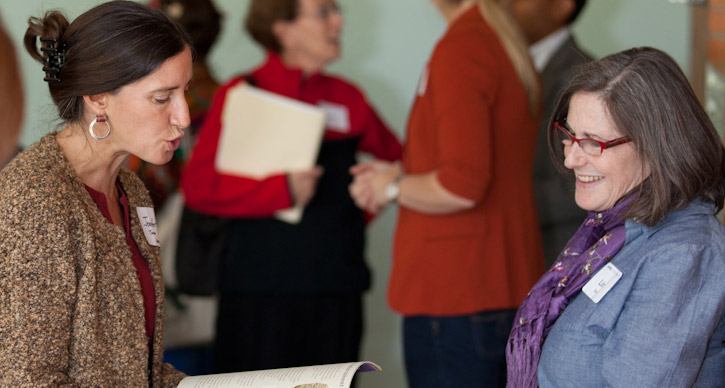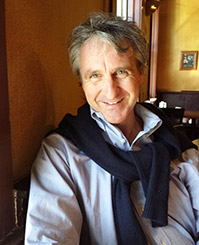Meet Members of Pedrito Martinez Group
The Pedrito Martinez Group performs in Ann Arbor on March 14, 2014 as part of a unique double-bill with the trio of Cuban Pianist Alfredo Rodríguez.
In this video, get a peek at the behind-the-scenes moments of producing the group’s debut records, and learn more about each member of the group:
Interested in more? Read our interview with Cuban Pianist Alfredo Rodríguez.
Buena Vista Social Club is a Party Foul

Photo: Pedrito Martinez Group. The group performs with Alfredo Rodríguez Trio on March 14, 2014 in Ann Arbor. Photo by Petra Richterova.
Has this ever happened to you? You find yourself in a conversation with someone who knows a lot about music (and probably craft brewed beer, artisanal fermented foods, and expensive jeans). When the topic shifts to Cuban music you make the mistake of saying something like, “Oh I love Cuban music, I listen to Buena Vista Social Club all the time.” A smirk quickly appears on the face of your friend. All of the air goes out of the room. You know you have said something terribly wrong, but you are not sure exactly what.
If this has ever happened to you (or even if it hasn’t), you need to get tickets to come see Alfredo Rodríguez and Pedrito Martínez, two talented young musicians from Cuba who are reworking the Cuban sounds they grew up with.
“The Special Period”
First a disclaimer: I love Buena Vista Social Club. I do not care who smirks at me for it. But here is a little context. Buena Vista Social Club appeared in 1997 during what Cubans call “The Special Period.” Cuba’s socialist economy entered a severe crisis after the fall of the Soviet Union, as trade and assistance from Communist Europe suddenly vanished. Meanwhile the United States tightened its trade embargo. In response, the Cuban government shifted its economic strategy towards the development of tourism and the marketing of Cuban culture to international audiences. At the same time, the Clinton administration loosened restrictions on travel by Cuban artists to the United States. Buena Vista Social Club – a phenomenon which includes an album, a film, and many international tours – was the most commercially successful cultural enterprise of this new landscape. And it is brilliant. But the vision of Cuba that Buena Vista Social Club sold was one where time had stood still: a world of crumbling Art Deco buildings, well maintained vintage automobiles, and picturesque elderly black performers playing exactly the same music that they had played in the decades before the revolution.
So the knock on Buena Vista Social Club is that it reintroduced international audiences to a Cuba that no longer existed. This was our loss, because the music that had evolved in Cuba in the 1970s and 1980s, and was still evolving in Cuba in the 1990s and beyond, was pretty special. This is where Alfredo Rodríguez and Pedrito Martínez come in. They came of age in Cuba in the Special Period, when “Chan Chan” played in every bar in Madrid and Paris, but that sort of music was only really heard in hotels catering to tourists in Cuba. Their music gives a glimpse of what was happening in Cuba as the elderly musicians of Buena Vista Social Club conquered the world.
Chan Chan:
Music: A hallmark of Cuban socialism
One of the amazing things about music in Havana in these years was the extent of conservatory training; expanded access to music education was a hallmark of the cultural policy of Cuban socialism. So it was not uncommon for popular musicians in Cuba in these years to have advanced classical training. Born in 1985, Alfredo Rodríguez, the son of well-known popular musician and television personality, grew up in this system. He moved back and forth between the classical training of the conservatory and the popular music he played with his father. Eventually he found his niche in the world of jazz. Cuban musicians from had been experimenting with jazz since the 1970s. By the 1990s, after the much-publicized visit of Dizzy Gillespie to Cuba, the top players in the Cuban jazz world became part of the international circuit. Some defected, but others simply enjoyed the new freedom to tour outside Cuba that came with the new economic strategies of the regime. Rodriguez was playing in Montreaux in 2006 when he met Quincy Jones. Then he was playing with his father’s band in Mexico when he decided to cross the border into the US to work with Quincy.
A second important musical trend in Cuba after the revolution was shifting official policy towards Afro-Cuban folkloric music, percussive styles like rumba, abakua, and batá (the music played during Santería ceremonies). African slaves and their descendants developed these styles of music in the context of spiritual practice and community life not the music industry. In the 1960s and 1970s, the master percussionists of these traditions became employees of state folklore agencies, performing Afro-Cuban music on stage. In the 1990s, folklore groups and the state began selling this version of Cuban culture abroad too. Afro-Cuban cultural groups like Muñequitos de Matanzas began travelling to the US. Pedrito Martínez grew up in this world, winning international competitions in Afro-Cuban hand drumming and entering the world of professional musicianship on international tours with Muñequitos de Matanzas. He also won international exposure as part of a rumba ensemble that appeared in the film Calle 54 (2000). We cannot link to video of this segment because of copyright, but it is worth watching on Netflix if you can.
Muñequitos de Matanzas during their first US tour in 1992:
Timba is perhaps the most important of all the musical innovations in Cuba during the Special Period. Timba was a dance music popular among the urban, Afro-descended Cubans who found themselves increasingly disenfranchised by the shifting economic strategies of the socialist government. Timba lyrics adopted street slang and discussed taboo subjects including the informal economy of hustling, linked to the growth in tourism. Built of the same materials as salsa, timba followed a distinct path. Most important was a restructuring of the classic Cuban dance music around explicitly Afro-Cuban rhythms and a much more experimental approach to rhythm in general. Batá or rumba variants were as likely to form the central rhythmic arguments as the classic son tumbaos. Timba also built on on the funk-fusion sound of the experimental jazz group Irakere.
NG La Banda Santa Palabra:
Bacalao con Pan:
Timba was the alter-ego of Buena Vista Social Club, young and edgy, informed by Cuban jazz, by Afro-Cuban folklore, and often played by musicians who had been trained in conservatories. The point is not that this music was more authentic, somehow free of the influence of marketing. The interplay of international promotion and local musical scenes helped produce a wide range of musical options in and around Cuba over the past twenty-five years, including a dizzying array of musical talent. The upcoming UMS concert offers a glimpse at this world. Alfredo Rodríguez is a conservatory trained technical virtuoso, with a background in Cuban popular music, who grew up idolizing Kieth Jarrett. He experiments at the boundaries between straight ahead jazz and Cuban jazz.
…y bailaría la negra:
Pedrito Martínez is a percussionist who played with Munequitos de Matanzas when that band was already making regular commercial tours around the world. He explores timba and Cuban funk fusion in a small quartet format, just a keyboard, bass, and bongó player to accompany his congas. Both musicians continue to rethink the music they grew up with in conversation with the wide range of international musicians and styles they embody.
Que palo:
Please do not smirk the next time someone tells you that they love of Buena Vista Social Club. Just smile, and tell them about the concert you just saw by Alfredo Rodríguez. Nod and lend them your copy of Pedrito Martínez’s new record with its amazing cover of of Robert Johnson.
Travelling Riverside Blues:
Educator Conversations: Pedrito Martinez Group
Editor’s note: This post is a part of a series of conversations between educators in the K-12 community. Educators will offer suggestions and answer questions about integrating UMS School Day Performances or the arts into classroom curriculum, as well as share advice on organizing a field trip to UMS. To volunteer to be a Teacher Lobby Moderator e-mail umsyouth@umich.edu. Or, check out other Educator Conversations.
This week’s questions:
- How does a teacher prepare students for a concert of Cuban music?
- How does an educator integrate this UMS performance into his or her classroom curriculum?
- What are 3 things I can do in a short time frame to make this a meaningful performance for my students?
This week’s moderator: Dan Tolly. Dan is a music educator in the Ann Arbor Public Schools.
Q: How does a teacher prepare students to attend a concert of Cuban music?
My approach to any topic I bring into my classroom is the same; as author Richard Peck says, “it’s all about the story.” In this case, it is important to make connections not just to the music, but also the culture and the artist(s). The “story” is what the students will connect with intellectually, emotionally; it has to have purpose and meaning. If there’s not something in any story that deepens their understanding of the world and is worth remembering for the rest of their lives, then it’s not worth the students’ time. Of course, this is rarely the case, unless a teacher doesn’t take time to research. UMS bringing the Pedrito Martinez Group to Ann Arbor offers area educators a great chance to meaningfully enrich their students’ lives.
A good place to start is with the artist’s biography, to learn his/her personal story and musical and intellectual influences. Pedrito Martinez was born in Havana, Cuba, in 1973. According to his website, he began his musical career at age 11. This is an age when our students begin taking instrumental music in school, so it’s something the students can relate to – envisioning the musician at that stage in life. Finding some documentary film clips on Cuba and Cuban music will help to introduce the students to the sights and sounds that influenced Pedrito. There are also numerous music videos available of the group.
Since Pedrito is fairly young, it is hard to find visual materials on his life (he is included in Calle 54, a documentary of Latin Jazz). To help tell the story of life in Cuba for musicians, the movie For Love of Country (the Arturo Sandoval story) is a great resource, and helps connect the music of Cuba to American Jazz through the connection of Dizzy Gillespie and Arturo. It’s fun to make connections to the artist and those who influenced him, or whose music he enjoys.
While Pedrito is not a household name here, he has recorded with and toured with some names your students will recognize: Wynton Marsalis, Paul Simon, and Paquito D’Rivera. He now lives in New York City (Manhattan) and the Pedrito Martinez Group generally plays three nights a week there. Tie-ins to these artists and their music can offer a nice segue to how musicians collaborate across cultures. In his weekly sets, he often plays his own arrangements of “I’ll Be There” by the Jackson Five, and Led Zeppelin’s “Traveling Riverside Blues,” as well as Latin Jazz pieces, ballads, and original compositions by Pedrito.
Q: How does an educator integrate this UMS performance into his or her classroom curriculum?
As mentioned above, if you weave a story around the performer, you can create meaningful connections to the broader curriculum of your classroom. Tying social studies/geography lessons to the performance can be done in two obvious ways: learning about Cuba, and more broadly about the geography of the African diaspora. Where are the countries located, who lives there, where did they come from? What are the economies based on, how do people live, what types of music do they enjoy (both traditional and contemporary), what is the political climate like? How are they governed? How does this compare to the core democratic values we learn about in our curriculum? I have found that telling the story of Cuban musicians’ lives and their defection to the United States helps to reinforce for our students just how important the rights we take for granted truly are.
Q: What are 3 things I can do in a short time frame to make this a meaningful performance for my students?
1. Purchase the debut album from the Pedrito Martinez Group (or begin by listening to the album on a streaming service like Spotify – embedded below). Play it for the students, and introduce them to the polyrhythms, so they’re familiar with the music and have something to listen for during the performance. Play the video clips from the group’s website.
2. Give your students some biographical information about Pedrito Martinez and the other musicians in the group – Alvaro Benavides (bassist, Venezuelan, Berklee-trained); Jhair Sala (percussionist, Peruvian, came to US to study with Pedrito); Ariacne Trujillo (pianist, vocalist, attended top Cuban conservatory).
3. Make connections to other composers/musicians that you may be covering with your students – Wynton Marsalis, Jackson Five, Led Zeppelin, Paul Simon, Quincy Jones. Have fun making connections through the music. Make at least one connection through geography, social studies, or literature.
Enjoy learning along with your students!
Do you have questions or comments for Dan about his approach to this performance or about teaching through performance more broadly? Share your responses or questions in the comments section below.
Daniel D. Tolly is a music educator whose passion and unique approach to teaching have been recognized with several awards, among them the American Historical Association’s Beveridge Family Teaching Prize, for excellence and innovation in K-12 history teaching; the University of Michigan University Musical Society’s Teacher of the Year; and earlier in his career, the National Association of Jazz Educators’ Director of the Year Award at the Wichita Jazz Festival. Dan has received several district-level teaching awards, and received multiple nominations for the new Grammy award for teachers in 2013. Dan currently teaches music in the Ann Arbor Public Schools, and is involved as master teacher with the NEH-funded Banner MomentsTeacher Institute. Dan is also a lead teacher and collaborator with a University of Michigan/El Sistema pilot program. His education includes graduate studies at the University of North Texas and the University of Michigan.
New! Educator Conversations

Photo: Emerson School educator Jennifer Tanau and UMS Advisory Committee member Linda Spector at a UMS reception for teachers. Photo by Mark Gjukich Photography.
This season, look for Educator Conversations on UMS Lobby.
Educators will offer suggestions and answer questions about integrating UMS School Day Performances or the arts into classroom curriculum, as well as share advice on organizing a field trip to UMS. To volunteer to be a Teacher Lobby Moderator e-mail umsyouth@umich.edu.
Educator Conversations will take place around UMS School Day Performances. As soon as the conversations are live, we’ll include a link on this page.
- Hubbard Street Dance Chicago with Melissa Poli (Performance September 27)
- Ukulele Orchestra of Great Britain with Katie Ryan (Performance November 12)
- Brooklyn Rider with Emily Barkakati (Performance November 25)
- One Night in Bamako with Jeff Gaynor (Performance February 7)
- Compagnie Käfig with Dianne Dudley (Performance February 13)
- Pedrito Martinez Group with Dan Tolly (Performance March 14)
- Jazz at Lincoln Center Orchestra with Wynton Marsalis with Linda Jones (Performance March 31)
Share you questions or comments below.



